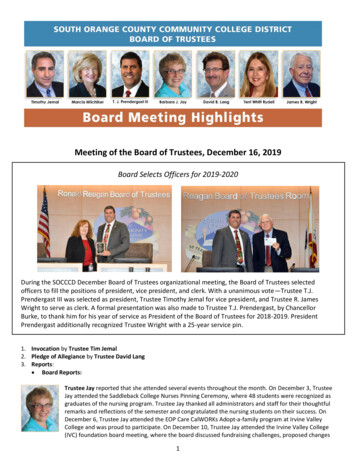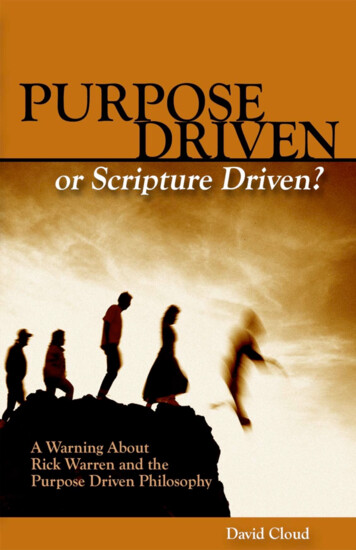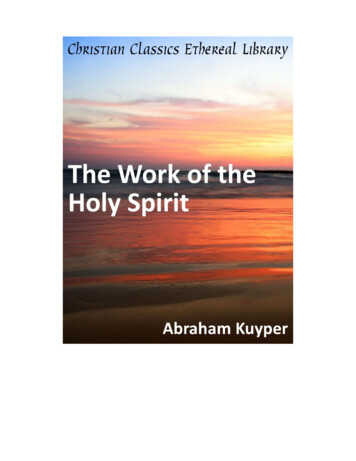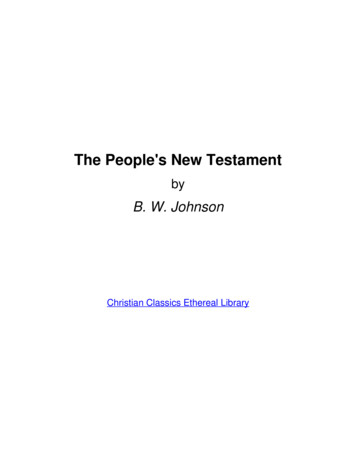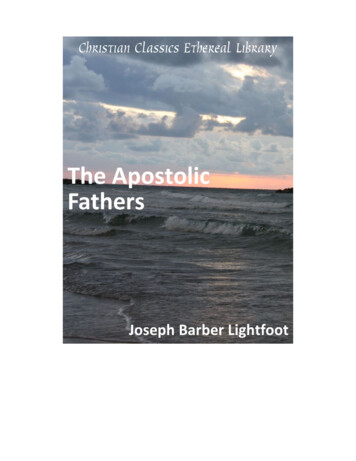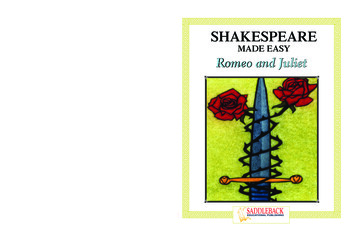
Transcription
SHAKESPEARE MADE EASY Romeo and JulietComplements Saddleback’s Classics, Saddleback’sIllustrated Classics or any Shakespeare playscriptSHAKESPEAREMADE EASYRomeoRomeo andand JulietJulietFor information on other Saddleback titles,visit our website: www.sdlback.com3 Watson Irvine, CA 92618 1-888-735-2225 sdlback.com
ContentsTo the Teacher . . . . . . . . . . . . . . . . . . . . . . . . . . . . . . . . . . . . . . . . . . . . . . . . . . . . . . . . . . . . vIntroduction to the Play . . . . . . . . . . . . . . . . . . . . . . . . . . . . . . . . . . . . . . . . . . . . . . . . . . . viIntroduction to Shakespeare . . . . . . . . . . . . . . . . . . . . . . . . . . . . . . . . . . . . . . . . . . . . . . . xivActivity 1: Current Events in Meter (The Prologue) . . . . . . . . . . . . . . . . . . . . . . . . . . . . . 1Activity 2: Three Civil Brawls (Act one, Scene 1) . . . . . . . . . . . . . . . . . . . . . . . . . . . . . . . . 2Activity 3: Love Is in the Air (Act one) . . . . . . . . . . . . . . . . . . . . . . . . . . . . . . . . . . . . . . . . 3Activity 4: Gossip Columnist at the Ball (Act one, Scene 5) . . . . . . . . . . . . . . . . . . . . . . . 4Activity 5: Review . . . . . . . . . . . . . . . . . . . . . . . . . . . . . . . . . . . . . . . . . . . . . . . . . . . . . . . . . 5Activity 6: The Balcony Rap (Act two, Scene 2) . . . . . . . . . . . . . . . . . . . . . . . . . . . . . . . . . 6Activity 7: Love Opinionnaire (Act two, Scene 2) . . . . . . . . . . . . . . . . . . . . . . . . . . . . . . . 7Activity 8: Friar Lawrence (Act two, Scene 3) . . . . . . . . . . . . . . . . . . . . . . . . . . . . . . . . . . . 8Activity 9: Figures of Speech (Act two) . . . . . . . . . . . . . . . . . . . . . . . . . . . . . . . . . . . . . . . . 9Activity 10: Review . . . . . . . . . . . . . . . . . . . . . . . . . . . . . . . . . . . . . . . . . . . . . . . . . . . . . . . 11Activity 11: Mad Mercutio . . . . . . . . . . . . . . . . . . . . . . . . . . . . . . . . . . . . . . . . . . . . . . . . . 12Activity 12: “O, I am fortune’s fool” (Act three, Scene 1) . . . . . . . . . . . . . . . . . . . . . . . . . 14Activity 13: Telling It to the Prince (Act three, Scene 1) . . . . . . . . . . . . . . . . . . . . . . . . . 15Activity 14: What the Servant Said (Act three, Scene 2) . . . . . . . . . . . . . . . . . . . . . . . . . 16Activity 15: Review . . . . . . . . . . . . . . . . . . . . . . . . . . . . . . . . . . . . . . . . . . . . . . . . . . . . . . . 17Activity 16: Romeo, the Outlaw (Act three, Scene 3) . . . . . . . . . . . . . . . . . . . . . . . . . . . . 18Activity 17: The Friar Speaks Up (Act three, Scene 3) . . . . . . . . . . . . . . . . . . . . . . . . . . . 19Activity 18: Writing a Soliloquy (Act three, Scene 5) . . . . . . . . . . . . . . . . . . . . . . . . . . . . 21Activity 19: Headlining (Act three) . . . . . . . . . . . . . . . . . . . . . . . . . . . . . . . . . . . . . . . . . . 22Activity 20: Review . . . . . . . . . . . . . . . . . . . . . . . . . . . . . . . . . . . . . . . . . . . . . . . . . . . . . . . 23Activity 21: The Friar’s Plan (Act four, Scene 1) . . . . . . . . . . . . . . . . . . . . . . . . . . . . . . . . 25Activity 22: Juliet’s Fears (Act four, Scene 3) . . . . . . . . . . . . . . . . . . . . . . . . . . . . . . . . . . . 26Activity 23: Juliet’s Letter of Explanation (Act four, Scene 5) . . . . . . . . . . . . . . . . . . . . . 27Activity 24: Comic Relief (Act four, Scene 5) . . . . . . . . . . . . . . . . . . . . . . . . . . . . . . . . . . 28iii
iv Shakespeare Made Easy: Romeo and JulietActivity 25: Review . . . . . . . . . . . . . . . . . . . . . . . . . . . . . . . . . . . . . . . . . . . . . . . . . . . . . . . 29Activity 26: The Poor Apothecary (Act five, Scene 1) . . . . . . . . . . . . . . . . . . . . . . . . . . . . 30Activity 27: The Letter (Act five, Scene 3) . . . . . . . . . . . . . . . . . . . . . . . . . . . . . . . . . . . . 31Activity 28: Obituaries . . . . . . . . . . . . . . . . . . . . . . . . . . . . . . . . . . . . . . . . . . . . . . . . . . . . 32Activity 29: An Interview with the Friar (Act five) . . . . . . . . . . . . . . . . . . . . . . . . . . . . . . . 33Activity 30: Review . . . . . . . . . . . . . . . . . . . . . . . . . . . . . . . . . . . . . . . . . . . . . . . . . . . . . . . 34Romeo and Juliet Final Test . . . . . . . . . . . . . . . . . . . . . . . . . . . . . . . . . . . . . . . . . . . . . . . . 36Culminating Activity 1: Happy Ending? . . . . . . . . . . . . . . . . . . . . . . . . . . . . . . . . . . . . . . 38Culminating Activity 2: Shakespeare’s Words Today . . . . . . . . . . . . . . . . . . . . . . . . . . . . 39Culminating Activity 3: Retelling the Story from a Different Perspective . . . . . . . . . . . . 40Culminating Activity 4: The Verona Daily Times . . . . . . . . . . . . . . . . . . . . . . . . . . . . . . . 41Culminating Activity 5: Romeo and Juliet, the Condensed Version . . . . . . . . . . . . . . . . . 42Culminating Activity 6: Who Is to Blame? . . . . . . . . . . . . . . . . . . . . . . . . . . . . . . . . . . . . 43Answer Key . . . . . . . . . . . . . . . . . . . . . . . . . . . . . . . . . . . . . . . . . . . . . . . . . . . . . . . . . . . . . . . 44
To the Teacheropportunities for the reader to make personalconnections with the text, and help busyteachers gain quick access to classroom-testedand age-appropriate activities that make theteaching of Shakespeare an easier task.As any teacher or student who has readShakespeare knows, his plays are not easy.They are thought-provoking and complex textsthat abound with romance, deceit, tragedy,comedy, revenge, and humanity shown at itsvery worst as well as its very best. In short, toread Shakespeare is to explore the depths andheights of humanity.Each regular activity, as well as each culminating activity, can be modified to be an individualor a group task, and the reviews and tests can beused as quick comprehension checks or formallyscored assessments. The guides may be usedin conjunction with the Barron’s ShakespeareMade Easy texts or alone. Ultimately, theShakespeare Made Easy Activity Guides areintended to assist teachers and students ingaining an increased understanding of andappreciation for the reading of Shakespeare.The Shakespeare Made Easy Activity Guidesare designed by teachers for teachers to helpstudents navigate this journey. Each guide isbroken into six sections of four activities andone review. At the end of each guide is a finaltest, a variety of culminating activities, andan answer key. The activities are meant toaid textual comprehension, provide creative 2006 Saddleback Educational PublishingvShakespeare Made Easy: Romeo and Juliet
Introduction to the Playto her lover. Mariotto does not hear about theplan, however, because pirates capture themessenger sent from from the friar. Mariottoarrives at Gianozza’s tomb, is recognized, andis killed. Gianozza joins a convent and diesof grief.Background to Romeo and JulietThe story of Romeo and Juliet was knownthroughout Europe and England beforeShakespeare wrote his version for the stagein about 1597. The main source for the playwas the poem by Arthur Brooke entitled TheTragical History of Romeus and Juliet. Brooke’sversion, printed about 30 years before Shakespeare wrote Romeo and Juliet, emphasizes thatRomeus and Juliet are ill-fated lovers and showsthe contrast between their love and the hatebetween their parents. The legend behindhis poem came from other literature in Franceand Italy. These earlier versions may also haveinfluenced Shakespeare. One Italian version ofthe story is from 1530 by Luigi Da Porto. In hisversion, the young lovers are called Romeo andGuilietta. As in Shakespeare’s play, Da Porto’sstory is set in Verona, Italy, and the young loversare children of feuding parents, the Montaguesand Capulets.Shakespeare was not afraid of using familiarmaterial in his plays. However, Shakespearemade some interesting adjustments to theplot to give his play more passion and drama.Shakespeare took the action that occursin Brooke’s poem over nine months andcompresses it into a few days. For example, inBrooke’s poem, many days pass between theball and Romeo and Juliet’s meeting in thegarden, instead of everything occurring on thesame night. In Brooke’s version, Romeo andJuliet are married for about two months, andeach night Romeo visits Juliet by climbing upa rope ladder to her room. In Shakespeare’sversion, Romeo and Juliet only have one nighttogether as man and wife. This collapsing oftime makes the events of the play more tragicand emotional.Even earlier, a similar story came from theItalian writer Masuccia of Salermo. In thisaccount, two lovers are married by a friar insecret. The boy, Mariotto, kills someone in aquarrel and is banished. His lover, Gianozza,takes a sleeping potion from the friar and isentombed in order to avoid marriage withsomeone her father wishes her to marry. Aftershe takes the potion and is presumed dead, thefriar frees her from the tomb so he can take her 2006 Saddleback Educational PublishingDue to the strong love story and the memorablecharacters, The Tragedy of Romeo and Julietquickly became one of Shakespeare’s mostpopular works. Even today, Romeo and Julietremains a favorite because of the passion andsadness of the love story and the beauty of thepoetry in the play.viShakespeare Made Easy: Romeo and Juliet
Introduction to the PlayMeanwhile, Count Paris is at the Capulets’estate, asking for permission to marry Juliet.Capulet gives his consent only if Paris winsJuliet’s love and if he can wait for two yearsbecause she is only thirteen.Synopsis of Romeo and JulietPrologueThis sonnet gives the plot and theme of theentire play: the story of the romance of twoyoung lovers. Because of the death of these two“star-crossed lovers,” the parents of the childrenend their bitter feud.Act one, Scene 3Juliet’s nurse and her mother speak to Julietabout Count Paris’s wish to marry her. Theyfeel that Paris would be a good match for Juliet,and Juliet responds by saying she will “look tolike” Count Paris, but will not proceed with anyrelationship without her parents’ consent.Act one, Scenes 1 and 2Samson and Gregory, who are related to theCapulets, express their hatred of the Montaguefamily. This hatred is a result of an ancient feudbetween the two families. Servants from thehouse of Montague walk by, and Samson andGregory taunt them. They begin to fight withswords. Benvolio, a Montague, tries to stop thefight, but when Tybalt, a Capulet, enters thescene, the fighting grows worse. Prince Escalusof Verona arrives and orders all brawls to endunder penalty of death.Act one, Scene 4Romeo and his friends proceed to the Capulets’ball. On the way, Mercutio gives a long andbeautiful speech about the Fairy Queen Mab,who can influence the dreams of people. Just asthey are entering the dance, Romeo feels fearabout the future.Romeo’s parents, the Montagues, are worriedabout Romeo’s moody sadness. They askBenvolio to try to find out what is botheringRomeo. He talks with Romeo and discoversthat Romeo is swooning with love over Rosaline, but she does not return his affection.Benvolio persuades Romeo to go to a maskedball given by the Capulets in order to compareRosaline with other lovely young women.There, Benvolio argues that Romeo will seethat he does not need to pine for Rosaline whenthere are other beautiful young women thatRomeo could love. 2006 Saddleback Educational PublishingAct one, Scene 5At the Capulets’ masked ball, Romeo instantlyfalls in love with a young woman whose beautyteaches the “torches to burn bright.” He speaksto her, and they kiss. The beautiful youngwoman is called away, and the Nurse tellsRomeo that his new love is Juliet, daughter andonly heir of the Capulets. Juliet also learns thatthe young man she has fallen in love with isa Montague and “the only son of your greatenemy.”viiShakespeare Made Easy: Romeo and Juliet
Introduction to the Playthem. The Friar is unsure of Romeo’s heartsince he changed his mind so fast. He cautions,“Wisely and slow. They stumble that run fast.”Still, the Friar likes the idea of making peacebetween the Montagues and Capulets, and heagrees to marry the pair.During the ball, Tybalt realizes that Romeohas crashed the party, but he is forbidden byCapulet to cause any trouble at the dance.However, Tybalt swears to pay back Romeolater.Act two, ChorusAct two, Scene 4In this sonnet, the Chorus tells how Romeo’slove for Rosaline has died, and Juliet is nowRomeo’s new love. Even though they areforbidden to meet, their love is stronger thanany other claim on their lives.Romeo meets up with Mercutio and Benvolio.Because of his new love for Juliet, Romeo is ina more social mood, and Mercutio notes, “Nowart thou sociable. Now art thou Romeo.” TheNurse arrives looking for Romeo and asks if heis serious about his relationship with Juliet. Hesays yes, and tells the Nurse to have Juliet tellher family she is going to confession, butinstead she will be married to Romeo at FriarLawrence’s cell.Act two, Scene 1Mercutio and Benvolio look for Romeo afterthe dance. Mercutio makes fun of Romeo’saffection for Rosaline, little realizing thatRomeo is now in love with Juliet.Act two, Scenes 5 and 6Act two, Scene 2Romeo is in the Capulets’ garden under Juliet’swindow. He overhears her as she says to thenight that she is in love with Romeo. He tellsher that he is in the garden, and they exchangepassionate words of love. Juliet asks Romeo ifhe is willing to commit to marriage, and he sayshe will. They part with great sadness but lookforward to a secret marriage.Juliet waits impatiently for the Nurse to returnwith news about Romeo. Upon returning, theNurse is tired and out of breath, but she enjoysdelaying the good news to Juliet. She finallytells Juliet to go to Friar Lawrence’s cell whereRomeo waits to marry her. At Friar Lawrence’scell, Romeo and Juliet once again declare theirlove for one another, and the Friar leads themto the church to be married.Act two, Scene 3Act three, Scene 1Romeo meets the Friar, who is collecting weedsand flowers for medicine. Romeo tells the Friarthat he doesn’t love Rosaline anymore but lovesJuliet instead and wishes the Friar to marryRomeo is in the streets of Verona after hiswedding, and meets his friends Benvolio andMercutio. His friends are in an argument withTybalt over Romeo’s presence at the Capulets’ 2006 Saddleback Educational PublishingviiiShakespeare Made Easy: Romeo and Juliet
Student NameDateACTIVITY 3Love Is in the AirBackgroundDirectionsAct oneWilliam Shakespeare has many characters talking about love in this act, perhapsto foreshadow how the characters will react to the events that are to come.After rereading the following lines that each character speaks, write a few sentencesthat tell what these lines show about how the character thinks of or regards love.Romeo (Scene 1, lines 170–178, 180–189):Benvolio (Scene 1, lines 220–222; Scene 2, lines 46–51):Juliet (Scene 3, lines 67–99):Mercutio (Scene 4, lines 17–18, 23–24, 27–32): 2006 Saddleback Educational Publishing3Shakespeare Made Easy: Romeo and Juliet
Student NameDateACTIVITY 4Gossip Columnist at the BallAct one, Scene 5BackgroundThe fact that a Montague slipped into a Capulet party would have been big newsfor a gossip columnist considering that both families were wealthy and well-known.Several important things happen in this scene that should interest the people ofVerona.DirectionsImagine that you are a gossip columnist for the Verona Daily Times, and you havesneaked into the Capulets’ masquerade ball. When people have their identitieshidden, they are more likely to be free in their actions and words. Write a roughdraft of the story you will run in the next edition of your paper. Be sure to includedetails of people who attended, any fights that occurred, and, of course, what goeson between Romeo Montague and Juliet Capulet at this fateful party. Write yourstory below. Use an additional sheet of paper, if necessary. 2006 Saddleback Educational Publishing4Shakespeare Made Easy: Romeo and Juliet
Student NameDateACTIVITY 5ReviewDirectionsAnswer the following. Write the letter of the correct answer in the space provided.For 4, 7, and 10, write true (T) or false (F) in the space provided.1. In Prince Escalus’s speech, we are toldthat the Capulets and Montagues havehad how many fights?a. twob. threec. fourd. five6. How old is Juliet?a. 12b. 13c. 14d. 167. True or false: Juliet is completelyagainst being paired with Paris.2. The play takes place in what country?a. Great Britainb. Francec. Italyd. Spain8. How does Romeo accidentally findout about the Capulet party?a. He reads the guest list for anilliterate servant.b. He finds an invitation on thestreet.c. He overhears Capulet speakingto a friend.d. none of the above3. Who attempts to calm down thefeuding servants and keep the peace?a. Mercutiob. Tybaltc. Romeod. Benvolio9. Why is Tybalt so angry at the party?a. He wants to dance with Rosaline,but she doesn’t want to dancewith him.b. He hates parties, but he was forcedto go.c. He finds out that Romeo is therebut can’t fight him.d. He thinks Juliet is too young to beset up with Paris.4. True or false: Romeo has been actingmelancholy lately because he lovesJuliet, but she is a Capulet andtherefore forbidden to him.5. What advice does Benvolio give toRomeo about his troubles with love?a. send his love flowersb. look at other girlsc. talk to his [Romeo’s] parentsabout itd. talk to his love’s father to try andget his approval 2006 Saddleback Educational Publishing10. True or false: As Romeo and Julietare “falling in love” at the ball, theyalready know that their relationshipwill be forbidden because of who theirparents are.5Shakespeare Made Easy: Romeo and Juliet
Romeo and Juliet The story of Romeo and Juliet was known throughout Europe and England before Shakespeare wrote his version for the stage in about 1597. The main source for the play was the poem by Arthur Brooke entitled The Tragical History of Romeus and Juliet. Brooke's version, printed about 30 years before Shakes-peare wrote Romeo and Juliet,
